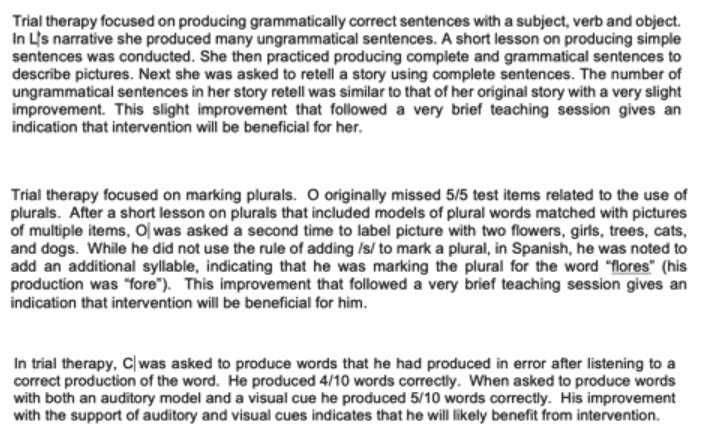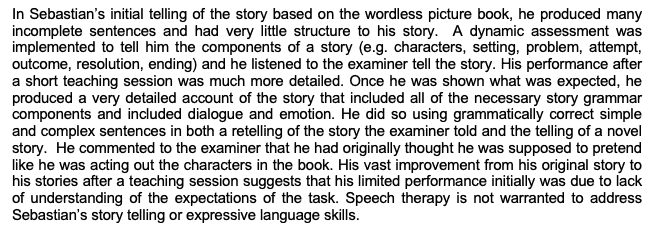Welcome back to our series on report writing. Today, we are going to talk about incorporating information about dynamic assessment procedures in your report. If you are new to the Report Writing Tip series, check out our first post in the series on setting up a report template and work your way through the series.
We’ve talked about quick ways to implement dynamic assessment into the overall assessment process. We use the Dynamic Assessment Protocol Form to create quick teaching sessions on different topics. Then we SAVE those for the next time we need to do a dynamic assessment of that particular skill or language feature. Now let’s talk about writing up the dynamic assessment portion. It’s a short paragraph packed with valuable information.
Here’s what it includes:
- What was the element of language you focused on (e.g., plurals, past tense verbs) in your dynamic assessment?
- A BRIEF description of what the teaching session looked like and what levels of support were included.
- The amount of change–how the student performed pre- and post- teaching.
- What that change means (e.g., make task easier, positive indicator that intervention will be beneficial, no intervention needed).
And that’s it. Here are a few examples I pulled from my reports.

And here are two examples of students whose dynamic assessment sessions indicated intervention was not warranted.
Next up: Pre-written goals





I would love to see the examples, I can’t open them. Any suggestions?
Hi, We reloaded the image of the examples so that you can see sample text.
I love the examples you included. Can you please also add examples where intervention was not recommended based on findings from dynamic assessment.
Maida,
Yes, done! I added two examples.
These are really helpful examples, thanks! I would also be interested to see some examples where the results indicate that intervention may not be beneficial, or, how you would suggest summarizing whether the results indicate typical or atypical development.
Hi Melinda,
I added two examples to the post for students whose dynamic assessment sessions indicated that intervention was not warranted. I go into this in much greater depth in the Dynamic Assessment course but in a nutshell, if a child makes excellent progress with minimal teaching, this is an indication they do not need intervention. If they make a little progress with a short teaching session it is a positive prognostic indicator for intervention. If they make no progress with a short teaching session, it tells me I need to back down on the task until they achieve some success, and that intervention is warranted.
Thanks so much! This is really helpful. I’ll definitely be sharing this with my team.
You are so welcome. Happy to hear you’re sharing with your team!
This is incredibly helpful! Thank you!
Glad you found it helpful!
I use dynamic assessment all of the time, modeled after Dr. Crowley’s protocol (see The Leader’s Project at Columbia University) – I love seeing your report examples and the document you created to collect data is wonderful. I will definitely be adding this to my assessment routine. Thank you for these amazing resources!
Hi Kathleen,
Thank you so much for the compliment! We love knowing that our materials and examples help SLPs!
Best,
Ellen